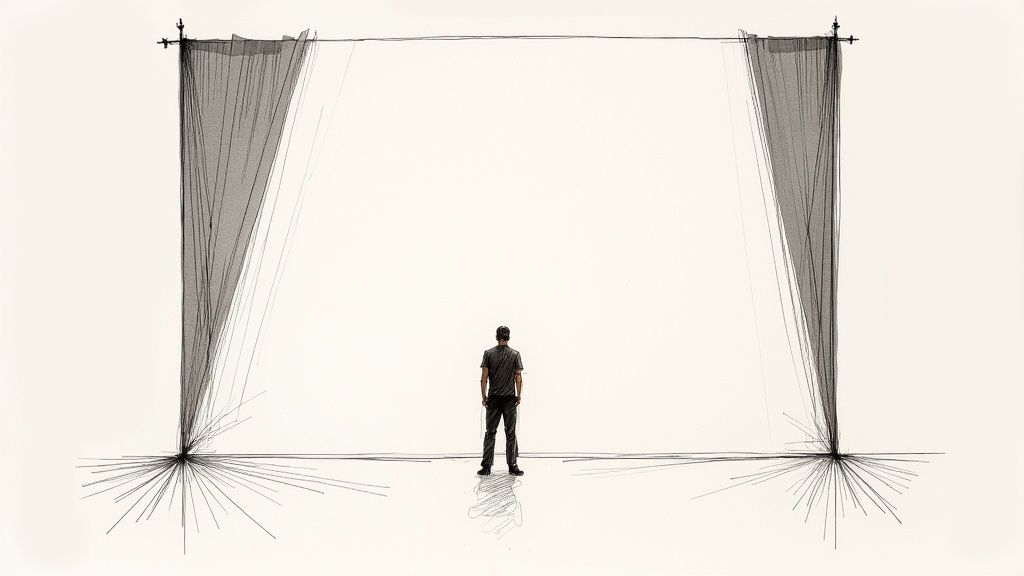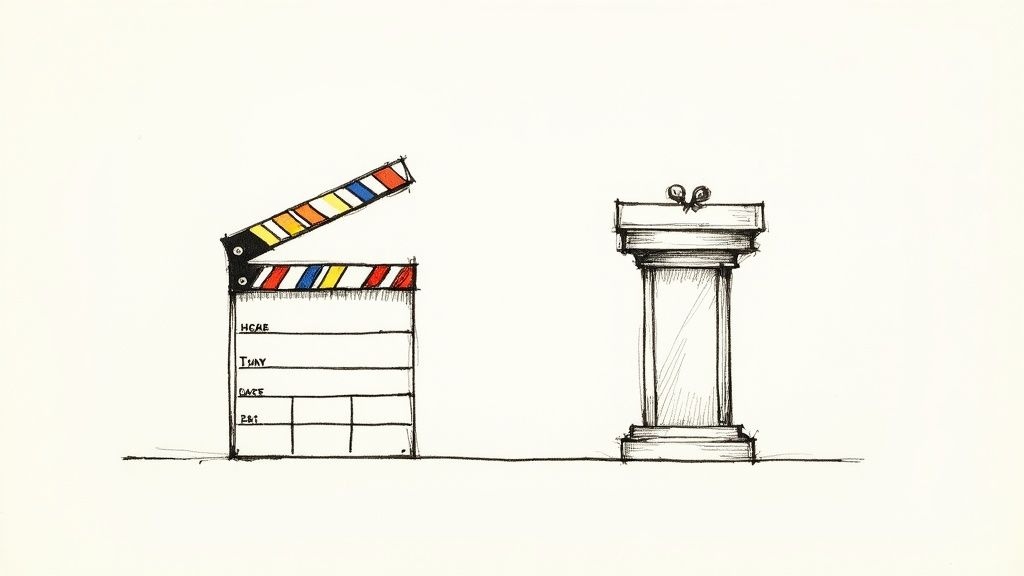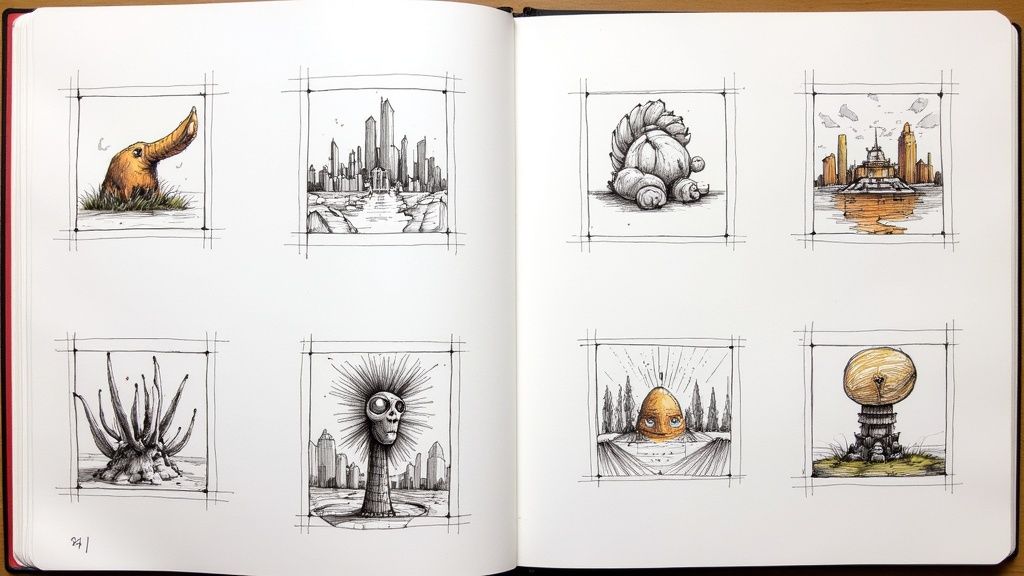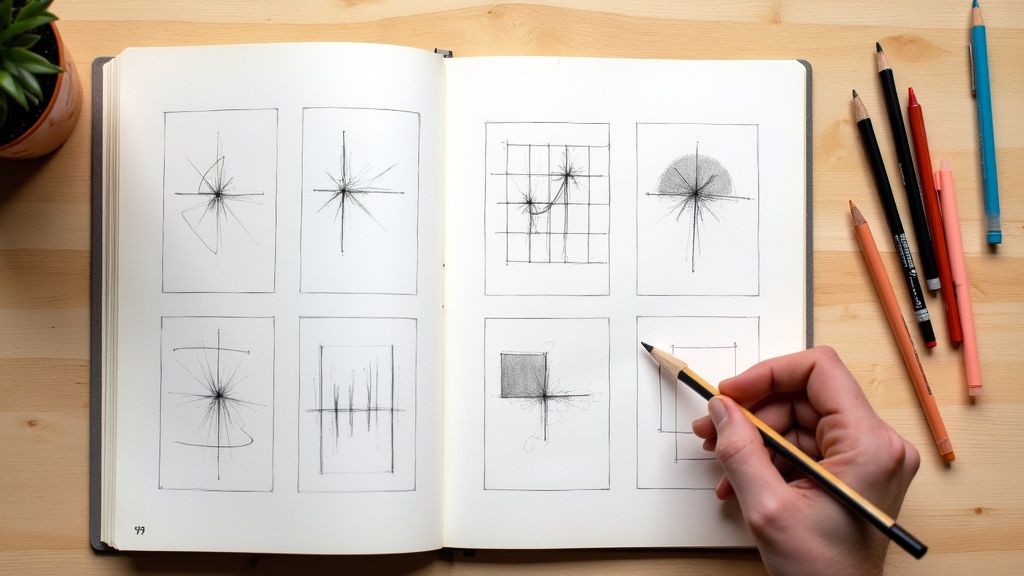Every great drawing begins with a single line, but every artist knows the real challenge is conquering the blank page. Staring at an empty sketchbook can be intimidating, a feeling that stifles creativity before it even starts. The solution isn't to wait for a rare bolt of inspiration, but to have a reliable toolkit of concepts ready to deploy. This guide is built to be that toolkit, a comprehensive collection of diverse and actionable sketch ideas designed to break through creative blocks and fuel your artistic practice. Whether you're a seasoned illustrator looking for a new perspective or a beginner hoping to build a consistent drawing habit, this list provides the spark you need.
We will move beyond generic prompts like "draw a cat" and instead explore specific themes, dynamic compositions, and unique subject matter. Each category is designed to challenge your skills and expand your visual vocabulary. You'll find concrete starting points for character design, environmental storytelling, abstract exploration, and much more. Think of this as your personal art director, providing focused assignments to get your pencil moving and your imagination firing. Prepare to fill your sketchbook with compelling and original work, one powerful idea at a time.
1. The Cold Open: Grabbing Attention from the First Second
A "cold open" is a powerful narrative device that throws the audience directly into a scene without any prior setup, credits, or introduction. Popularized by shows like Saturday Night Live, it’s designed to hook viewers immediately with a punchy, self-contained story. For artists and creators looking for compelling sketch ideas, the cold open format offers a structured yet dynamic framework to practice concise storytelling and character development.

The core principle is immediacy. You have a very short window, often just a page or two in a sketchbook, to establish a scenario, build to a comedic or dramatic climax, and deliver a satisfying resolution. This format forces you to be efficient with your visual language, focusing on expressions, body language, and environmental details that quickly communicate the story.
How to Structure a Cold Open Sketch
Think of it as a three-act play shrunk into a few panels. First, establish a familiar, relatable situation. Then, introduce an unexpected twist or exaggeration. Finally, deliver a punchline that resolves the absurdity. The Office perfected this with its documentary-style cold opens, where a mundane workplace scenario, like Jim Halpert putting Dwight Schrute’s stapler in Jell-O, escalates to a hilarious conclusion.
For your sketchbook, this could be a single-panel drawing or a short comic strip. Consider these sketch ideas:
- A knight in full armor patiently waiting in a long line at a modern coffee shop.
- Two squirrels having an overly dramatic argument with tiny, theatrical gestures.
- A superhero trying to discreetly use a coupon at the grocery store checkout.
Actionable Tips for Your Sketchbook
To make your cold open sketches effective, concentrate on clarity and impact. The viewer should understand the premise within seconds.
- Start with a strong hook: Your opening panel must create an immediate question or reaction. A strong visual contrast or an unusual character expression works well.
- Keep the premise simple: Don’t overcomplicate the scene. The humor or drama should come from one central, clear idea.
- Focus on the punchline: The final image or line of dialogue is crucial. It’s the payoff that makes the entire sketch work, providing a memorable, shareable moment.
2. Character-Based Recurring Sketches
Recurring characters are the backbone of many legendary sketch comedy series. These sketches revolve around a single, unforgettable personality whose exaggerated quirks, catchphrases, and predictable reactions drive the humor. The comedy builds not just within a single sketch, but over time, as the audience grows to know and anticipate the character’s behavior in various new situations.

The power of this format lies in familiarity and repetition. By creating a strong, memorable persona, you establish a reliable comedic engine. The audience finds comfort and delight in seeing how this known quantity, whether it's Bill Hader's Stefon describing an outlandish club or Dana Carvey's holier-than-thou Church Lady, will react to a fresh scenario. This makes it a fantastic framework for developing compelling sketch ideas.
How to Structure a Character-Based Sketch
The goal is to place your character in a situation that highlights their core comedic trait. First, establish a mundane or recognizable setting. Next, introduce your character and allow their defining mannerism or worldview to clash with the normalcy of the environment. The humor escalates as the character's predictable behavior derails the situation entirely. Think of Wayne and Garth from Wayne's World hosting their public-access show from a basement, applying their slacker logic to celebrity interviews.
For your sketchbook, this offers a chance to explore a character through multiple drawings. You can find excellent inspiration from these character drawing prompts on drawinglist.com. Consider these sketch ideas:
- An overly enthusiastic medieval town crier who now announces mundane office memos.
- A classic film noir detective trying to solve the mystery of a missing office stapler.
- A pirate captain who strictly adheres to modern HR policies with his crew.
Actionable Tips for Your Sketchbook
To create a successful recurring character, focus on a singular, powerful comedic hook that you can explore from different angles. Consistency is key to building audience recognition.
- Develop one strong, memorable trait: Is your character comically naive, arrogant, anxious, or clueless? Base their entire worldview around this one flaw or quirk.
- Create a distinctive voice or physical mannerism: A unique posture, a repeated gesture, or a catchphrase makes the character instantly identifiable and memorable.
- Vary the scenarios: The character should remain consistent, but the situations must change. The comedy comes from seeing the same reactions applied to different problems.
3. Parody and Satire Sketches
Parody and satire are timeless forms of comedy that leverage imitation to make a powerful point. These sketches humorously mimic and critique recognizable subjects like popular culture, celebrities, political events, or media formats. The goal is to exaggerate familiar elements to expose underlying absurdities, creating smart commentary that is both funny and insightful, making it a goldmine for compelling sketch ideas.

The core principle is exaggerated familiarity. Effective parody works because the audience already understands the source material. By taking a well-known style, character, or situation and twisting it, you create an instant connection and a foundation for comedy. This approach, mastered by creators like "Weird Al" Yankovic and the minds behind Key & Peele, allows artists to explore complex themes in an accessible, entertaining way.
How to Structure a Parody Sketch
Successful parody requires a deep understanding of what you are mocking. First, choose a specific target, whether it’s a film genre, a reality TV show, or a public figure. Next, identify its most distinct and recognizable tropes, mannerisms, or clichés. Finally, amplify those elements to a comedic extreme. Think of Saturday Night Live's "Celebrity Jeopardy," which doesn't just imitate the show but exaggerates celebrity personas for maximum comedic effect.
For your sketchbook, this offers a rich well of ideas:
- A scene from a dramatic fantasy epic, but the characters are arguing over who gets the last slice of pizza.
- A classic film noir detective monologue, but the mystery is about a missing sock.
- Draw a popular pop star performing their hit song, but with lyrics about the struggles of assembling IKEA furniture.
Actionable Tips for Your Sketchbook
To create effective parody and satire, your sketch ideas need to strike a balance between sharp criticism and genuine humor. The goal is to be clever, not cruel.
- Study your source material: The best parodies come from a place of knowledge. Watch the show, listen to the music, or study the person you are satirizing to capture the small details.
- Identify the core to exaggerate: What makes your target unique? Is it a specific catchphrase, a visual style, or a common plot device? Isolate that one element and blow it out of proportion.
- Find the comedic truth: Satire works best when it highlights a genuine absurdity or hypocrisy. Your sketch should have a point of view that makes the audience think as they laugh.
4. Escalating Absurdity Sketches
Escalating absurdity is a classic comedic technique where a sketch begins with a perfectly normal, relatable situation and gradually unravels into chaos. The humor builds methodically as each new detail pushes the boundaries of logic further, taking the audience on a journey from the mundane to the utterly bizarre. For artists seeking fresh sketch ideas, this structure is a goldmine for creating memorable and hilarious narratives.

The strength of this format lies in its gradual build. Unlike a sudden, random punchline, the comedy feels earned because it follows an internal, albeit warped, logic. The audience is in on the joke, watching with anticipation to see just how far the situation can spiral out of control. It’s a powerful tool for exploring character, as the absurdity often reveals the hidden anxieties or stubbornness of the people involved.
How to Structure an Escalating Absurdity Sketch
Your goal is to create a snowball effect of weirdness. Start with a simple, grounded premise. Introduce a small, unusual element. Then, have characters react to that element in a way that makes the situation even stranger. Comedy troupes like Monty Python and Key & Peele mastered this, starting sketches like a customer returning a faulty product or a substitute teacher mispronouncing names and escalating them to legendary heights of absurdity.
For your sketchbook, this structure offers a fantastic narrative arc. Consider these sketch ideas:
- A person trying to parallel park, but with each attempt, the parking spot itself changes shape or location.
- Someone ordering a pizza where each topping they request adds a bizarre new rule to the transaction.
- An artist trying to draw a portrait, but their subject’s face keeps subtly changing features with every glance.
Actionable Tips for Your Sketchbook
The key to a successful escalation is making each step feel like a logical, if ridiculous, progression from the last. The audience should be able to follow the chain of events, even as it becomes more surreal.
- Establish the "normal" first: Ground the scene in reality. The more relatable the starting point, the funnier the eventual departure from it will be.
- Escalate in believable steps: Each new twist should be a reaction to the previous one. Avoid jumping straight to maximum chaos; let the absurdity build organically.
- Keep characters consistent: A character’s motivation should remain constant, even as their environment becomes insane. Their commitment to their original goal is often the engine of the comedy.
5. Observational Comedy Sketches
Observational comedy sketches find humor in the mundane, taking everyday situations and social norms and dissecting them until their inherent absurdity is exposed. This style, famously championed by comedians like Jerry Seinfeld, relies on the audience's shared experiences, creating a powerful sense of "it's funny because it's true." For artists seeking relatable sketch ideas, this approach provides a rich wellspring of content drawn directly from real life.
The central principle is relatability. The comedy isn’t derived from a fantastical premise but from keenly observing and slightly exaggerating the peculiar behaviors, frustrations, and unspoken rules of our daily existence. This format challenges you to become a better observer, to notice the small, often overlooked details of human interaction and find the comedic gold within them.
How to Structure an Observational Sketch
Think of these sketches as a magnifying glass on a familiar moment. First, present a universally recognized scenario. Next, introduce a character who either questions the bizarre logic of the situation or fully leans into its strangeness. Finally, resolve the scene with a punchline that highlights the core truth of the observation. Portlandia excelled at this by examining niche social trends, like artisanal pickling, and blowing them up to hilarious proportions.
For your sketchbook, this could be a character study or a short visual narrative. Consider these sketch ideas:
- A person at a self-checkout machine having a one-sided argument with the automated voice.
- The awkward, silent dance two people do when trying to pass each other in a narrow hallway.
- Someone meticulously arranging their groceries on the conveyor belt, creating a bizarre, unspoken hierarchy.
Actionable Tips for Your Sketchbook
To make your observational sketches land, focus on authenticity and exaggeration. The viewer needs to recognize the situation instantly before they can appreciate the comedic twist. For even more inspiration, explore a variety of funny drawing ideas on drawinglist.com that can spark your next observational piece.
- Find a unique angle: Don't just point out that airline food is bad. Instead, draw the passenger who treats it like a gourmet meal, complete with a tiny napkin on their lap.
- Exaggerate recognizable behaviors: Take a common habit, like someone who talks with their hands, and amplify it until they are conducting a full orchestra while ordering coffee.
- Focus on the emotional truth: The best observational humor connects with a real feeling, whether it's frustration, confusion, or social anxiety. Capture that emotion in your characters' expressions.
6. Game Show and Talk Show Parodies
A game show or talk show parody is a classic sketch format that leverages a well-known television structure to create humor. By placing absurd characters, bizarre topics, or surreal events within the familiar confines of these formats, you create a powerful comedic contrast. This approach is one of the most reliable sketch ideas because the audience already understands the rules, allowing you to focus on subverting their expectations for maximum impact.
The core principle is structured chaos. The rigid format of the show acts as a container for increasingly ridiculous content. Whether it’s a celebrity unable to answer simple questions in SNL's "Celebrity Jeopardy" or the awkward, passive-aggressive tension in Between Two Ferns, the humor comes from the friction between the professional presentation and the flawed, funny people within it. This format is perfect for developing strong character voices and practicing comedic timing.
How to Structure a Parody Sketch
Think of the show's format as your script's skeleton. First, establish the show's identity and introduce the host. Next, bring on the guests or contestants, who are the source of the chaos. Finally, let the interaction unfold according to the show's rules, building the absurdity until a final punchline or chaotic conclusion.
For your sketchbook, this concept offers a fantastic template for character design and scene composition. You can create a multi-panel comic or a single, dynamic illustration. Consider these sketch ideas:
- A talk show where the host is interviewing a ghost who can only communicate by knocking over mugs.
- A baking competition show where all the contestants are grizzled medieval blacksmiths.
- A game show called "Is It a Dog?" where contestants struggle to identify common animals.
Actionable Tips for Your Sketchbook
To make your parody sketches effective, your love for the source material must shine through, even as you mock it. The details are what sell the joke.
- Study the source: Watch the show you’re parodying. Note the camera angles, theme music, host's catchphrases, and on-screen graphics. Replicating these details makes the parody feel authentic.
- Develop a strong host: The host is the anchor. Whether they are blissfully unaware, barely containing their frustration, or completely unprofessional, their consistent personality grounds the sketch.
- Balance structure and absurdity: Follow the show’s format (e.g., introductions, a question round, a final challenge) but fill each segment with something unexpected. The structure is the setup; the characters are the punchline.
7. Physical Comedy and Slapstick Sketches
Physical comedy sketches rely on visual humor, exaggerated body movements, and slapstick gags rather than clever dialogue. This classic form of comedy, popularized by titans like Charlie Chaplin and Rowan Atkinson as Mr. Bean, finds its humor in pratfalls, clumsy interactions, and mistimed actions. For artists, this provides a fantastic opportunity to explore storytelling through pure action and expression, making it one of the most dynamic sketch ideas for a visual medium.
The power of physical comedy lies in its universality. A well-drawn slip on a banana peel is funny in any language. It challenges you to convey timing, weight, and impact entirely through your lines and composition, pushing you to become a more effective visual communicator. The goal is to make the viewer feel the awkwardness or see the impending disaster.
How to Structure a Physical Comedy Sketch
Most slapstick scenes follow a clear setup-action-reaction sequence. First, you establish a normal situation. Then, you introduce a physical conflict or mishap. Finally, you show the exaggerated result. Think of Mr. Bean trying to change into his swimming trunks at the beach without anyone seeing him, a simple goal that leads to a cascade of hilarious physical contortions.
Your sketchbook is the perfect stage for these silent comedies. Try drawing these sketch ideas to practice the form:
- A chef attempting to flip a pancake with far too much enthusiasm, sending it flying across the kitchen.
- A character trying to quietly assemble flat-pack furniture, only for it to collapse in a complex, cartoonish way.
- Someone walking into a glass door they didn’t see, capturing the split-second of impact and surprise.
Actionable Tips for Your Sketchbook
To make your physical comedy sketches land, focus on exaggerating motion and conveying clear cause-and-effect. For those just starting, exploring these concepts can be a great entry point; you can find more sketchbook ideas for beginners on drawinglist.com to build foundational skills.
- Use action lines and smears: Motion lines, blurs, and smears are crucial for showing speed and direction. They turn a static image into a moment of chaotic energy.
- Exaggerate expressions and poses: Push the anatomy of your characters. A huge, wide-eyed gasp or a body bent into an unnatural shape sells the comedy of the moment.
- Make props a character: The environment is key. A wobbly ladder, a slippery floor, or a mischievous rake can be the source of the entire gag.
7 Sketch Idea Types Comparison
Sketch Type | Implementation Complexity | Resource Requirements | Expected Outcomes | Ideal Use Cases | Key Advantages |
|---|---|---|---|---|---|
The Cold Open | Moderate - short, no setup needed | Low - brief, minimal cast/props | Immediate audience engagement | Show openings needing quick attention | Hooks viewers instantly; topical humor |
Character-Based Recurring | High - requires character building | Moderate - consistent performers | Builds audience loyalty and anticipation | Long-running shows with recurring roles | Strong character recognition; merchandising |
Parody and Satire | Moderate - requires source knowledge | Moderate - script and cast | Social/political commentary with humor | Current events, pop culture | Broad appeal; timely cultural critique |
Escalating Absurdity | High - complex timing and pacing | Moderate - inventive staging | Unpredictable, memorable comedic buildup | Surreal or absurd humor | Keeps audience engaged; creative freedom |
Observational Comedy | Moderate - subtle writing skill | Low - relatable everyday settings | Relatability and insightful humor | Social situations, daily life | Highly relatable; timeless appeal |
Game Show and Talk Show Parodies | Moderate - format familiarity needed | Moderate - host and cast | Familiar format with absurd twists | TV format parodies | Flexible humor types; instant recognition |
Physical Comedy and Slapstick | High - precise choreography | High - props, safety measures | Visual humor transcending language barriers | Physical humor-focused sketches | Universal appeal; memorable physical gags |
From Idea to Execution: Your Next Steps
We've explored a wide spectrum of foundational sketch ideas, from the punchy cold open to the intricate humor of parody and the delightful chaos of escalating absurdity. Each format, whether it's the relatable world of observational comedy or the structured silliness of a game show parody, offers a unique toolbox for crafting memorable and effective comedy. The core takeaway is that structure is not a limitation; it is a launchpad for creativity. Understanding these templates allows you to build, twist, and subvert audience expectations with confidence.
The journey from a blank page to a finished sketch is rarely a straight line. The true value lies in the process of experimentation and consistent practice. The difference between a novice and a seasoned writer isn't a magical well of perfect ideas, but rather the dedication to generating and refining a large volume of concepts. Many of your initial sketch ideas will feel clunky or fall flat, and that is a critical part of the process. Each attempt sharpens your comedic instincts and your understanding of what truly connects with an audience.
Turning Concepts into Tangible Sketches
To truly internalize these frameworks, you must move from passive learning to active creation. The goal is to make these structures second nature, so you can focus on the unique comedic voice you bring to them.
Here are some actionable next steps to start building your portfolio of sketch ideas:
- The 24-Hour Challenge: Pick one format from this article. For the next 24 hours, actively look for a real-world trigger for that format. See a strange news headline? Turn it into a cold open. Overhear an odd conversation at a coffee shop? Use it as the basis for an observational sketch. Write a one-page draft before the day is over.
- Character Journaling: Dedicate a notebook (physical or digital) specifically to character creation. When you observe a peculiar habit, a unique vocal tic, or a strong opinion, jot it down. Ask yourself: What if this trait was amplified by 100? This journal will become an invaluable resource for developing hilarious recurring characters.
- The Parody Power-Up: Choose a movie or TV show you know inside and out. Select a single, well-known scene and write a one-page parody. Don't just mimic it; introduce a single, absurd element that derails the original scene's logic. This exercise hones your ability to identify and exploit established conventions.
The Lasting Impact of Consistent Practice
Mastering these concepts transforms you from someone who simply has funny sketch ideas into someone who can execute them effectively. It's about building a versatile skill set that allows you to tackle any comedic challenge. By consistently writing, observing, and playing with these formats, you develop the muscle memory needed to spot comedic potential everywhere and the technical skill to bring it to life on the page or screen. Your creative journey is fueled by action, so pick a starting point and begin writing today.
Ready for an endless stream of creative sparks to fuel your next project? The Drawing List idea generator is the perfect tool for artists and writers seeking fresh, unexpected sketch ideas. Visit Drawing List to instantly generate unique character concepts, absurd situations, and visual prompts that will break you out of any creative rut.


